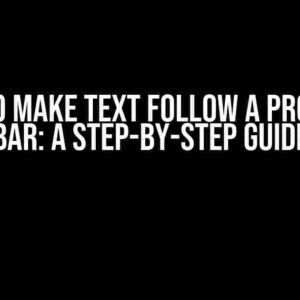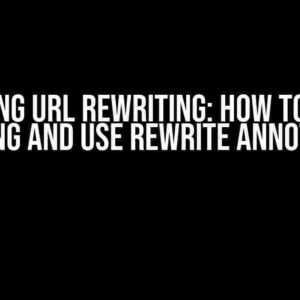Are you excited to tap into the potential of WebAssembly (WASM) in your Next.js application? You’re not alone! With WASM, you can unlock blazing-fast performance, compile languages like C and C++ to web-friendly code, and create a more secure and efficient web experience. But, if you’re new to the world of WebAssembly, you might be wondering: “How do I import my WebAssembly into Next.js?” Fear not, dear developer, for this comprehensive guide is here to walk you through the process.
Prerequisites: Getting Your Environment Ready
Before we dive into the nitty-gritty of importing WASM into Next.js, make sure you have the following setup:
- A basic understanding of Next.js and its file structure
- A code editor or IDE of your choice (we’ll use VSCode throughout this tutorial)
- Node.js and npm installed on your machine
- A WebAssembly module (WASM file) ready to be imported (we’ll create one in a bit)
Step 1: Preparing Your WebAssembly Module
For this example, we’ll use the Emscripten compiler to create a simple “Hello, World!” WebAssembly module. If you already have a WASM file, feel free to skip this step.
// Create a new directory for our project and navigate into it mkdir wasm-nextjs-example cd wasm-nextjs-example // Install Emscripten using npm npm install emscripten // Create a new C file (hello.c) with the following content: // hello.c #includeint main() { printf("Hello, World!\n"); return 0; } // Compile the C file to WebAssembly using Emscripten em++ hello.c -o hello.wasm -s WASM=1
Voilà! You now have a `hello.wasm` file in your project directory.
Step 2: Creating a Next.js Project
Let’s start by creating a new Next.js project:
// Create a new Next.js project using the create-next-app tool npx create-next-app wasm-nextjs-example // Navigate into the project directory cd wasm-nextjs-example
This will scaffold a basic Next.js project with the following structure:
wasm-nextjs-example pages api _app.js index.js public styles globals.css next.config.js package.json
Step 3: Adding WebAssembly Support to Next.js
In order to use WebAssembly in our Next.js application, we need to add the required dependencies and configure the `next.config.js` file:
// Install the required dependencies
npm install --save-dev @wasm-tool/wasm-loader wasm-webpack-plugin
// Update next.config.js to include WebAssembly support
module.exports = {
//... other configurations ...
webpack: (config) => {
config.module.rules.push({
test: /\.wasm$/,
type: 'webassembly/experimental',
});
return config;
},
plugins: [
//... other plugins ...
new WasmWebpackPlugin({
wasmLoader: 'wasm-loader',
}),
],
};
This configuration tells Next.js to use the `wasm-loader` to handle WebAssembly files.
Step 4: Importing and Using Your WebAssembly Module
Now that we have our WebAssembly module and Next.js project set up, it’s time to import and use the WASM file in our application:
// Create a new file called wasm.js in the pages directory
// pages/wasm.js
import wasm from '../hello.wasm';
const wasmModule = async () => {
try {
const wasmInstance = await WebAssembly.instantiate(wasm, {});
const { instance } = wasmInstance;
instance.exports.main();
} catch (err) {
console.error(err);
}
};
export default function WasmPage() {
return (
);
}
In this example, we import the `hello.wasm` file and use the `WebAssembly.instantiate()` method to create an instance of our WASM module. We then call the `main()` function exported by the WASM module when the button is clicked.
Putting it All Together
Let’s summarize the steps we’ve taken so far:
- Created a new WebAssembly module using Emscripten
- Created a new Next.js project
- Added WebAssembly support to Next.js
- Imported and used the WebAssembly module in our Next.js application
Start your Next.js development server by running `npm run dev` and navigate to `http://localhost:3000/wasm` in your browser. You should see a button that, when clicked, prints “Hello, World!” to the console.
Troubleshooting and Optimizations
If you encounter any issues or want to optimize your WebAssembly experience, here are some additional tips:
| Issue | Solution |
|---|---|
| Error: “Failed to execute ‘compile’ on ‘WebAssembly’: Incorrect response MIME type “ | Ensure that your WebAssembly file is being served with the correct MIME type (application/wasm) in your Next.js configuration. |
| Error: “WebAssembly module is not a function” | Verify that your WebAssembly module exports a function that can be called from JavaScript. |
| Optimizing WASM file size | Use the Emscripten compiler’s optimization flags (-O1, -O2, -O3) to reduce the size of your WASM file. |
| Loading WASM modules asynchronously | Use the `WebAssembly.instantiateStreaming()` method to load WASM modules asynchronously, reducing the initial page load time. |
And that’s it! You now have a solid foundation for using WebAssembly in your Next.js application. Remember to explore the vast possibilities of WASM, from accelerating scientific simulations to building blazing-fast web applications.
Conclusion
In this comprehensive guide, we’ve covered the steps necessary to import and use a WebAssembly module in a Next.js application. By following this tutorial, you’ve taken the first step in unlocking the potential of WebAssembly in your web development journey. Don’t be afraid to experiment, optimize, and push the boundaries of what’s possible with WASM.
Happy coding, and see you in the world of WebAssembly!
Frequently Asked Question
Got questions about importing WebAssembly into Next.js? We’ve got answers!
What is the best way to import WebAssembly into Next.js?
You can import WebAssembly into Next.js by using the `wasm-pack` plugin. First, install `wasm-pack` as a dev dependency, then create a `wasm` file in your project’s root directory, and finally, import it in your Next.js page using the `import` statement.
Do I need to use a specific loader for WebAssembly in Next.js?
Yes, you’ll need to use a WebAssembly loader, such as `wasm-loader` or `next/wasm`, to load your WebAssembly module in Next.js. These loaders will take care of loading and instantiating your WebAssembly module.
Can I use WebAssembly with Server-Side Rendering (SSR) in Next.js?
Yes, you can use WebAssembly with SSR in Next.js! Just make sure to use the `getStaticProps` or `getServerSideProps` methods to load your WebAssembly module on the server-side, and then pass the instance to your page component.
How do I handle errors when importing WebAssembly into Next.js?
When importing WebAssembly into Next.js, you can handle errors by using try-catch blocks and checking for any errors when loading or instantiating your WebAssembly module. You can also use Next.js’s built-in error handling mechanisms, such as `ErrorBoundary` components.
Are there any performance considerations when importing WebAssembly into Next.js?
Yes, when importing WebAssembly into Next.js, you should consider the performance implications of loading and instantiating your WebAssembly module. Make sure to optimize your WebAssembly code, use caching, and consider code splitting to minimize the impact on your application’s performance.




